新概念starterB-unit14完整课件
- 格式:doc
- 大小:22.00 KB
- 文档页数:5
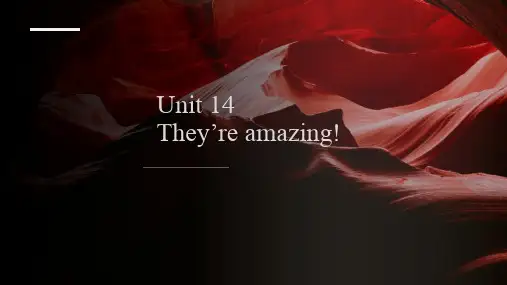
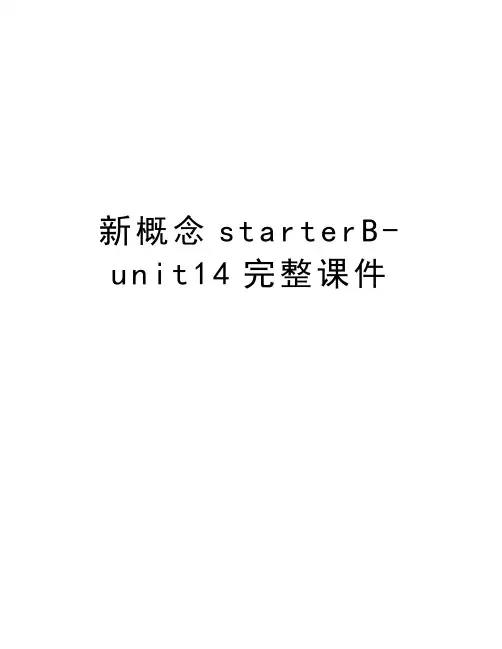
新概念s t a r t e r B-u n i t14完整课件新概念starter B unit14讲解单词和句型【Words】amazing adj.令人吃惊的,惊人的stand v.站,站立hungry adj. 饿的,饥饿的shout v.叫,惊叫wet adj.湿的,湿润的fat adj.胖的,肥胖的用卡片给学生展示单词,并让学生边写边记,每个单词抄写3遍。
【句型】1.I’m, we’re/I’m not, we aren’t2.You’re, you’re/ you aren’t you aren’t3.he’s, he isn’t/ she’s she isn’t/ it’s it isn’t4.they’re they aren’t【grammar】1.一般现在时一般疑问句和否定句的变法一、先将句子分成三类:1)含有am, is, are 的句子。
2)含有行为动词的句子,(如like,have,play,eat,run,need)3)含有情态动词的句子,如can。
(1)如果是第一类,即含有am, is, are 的句子。
只将把am, is, are 调到句首。
I am 和We are 要变成are you,some变成any,my变成your,句末用问号。
否定句只在be后加not。
如am---am not; is ---isn’t; are----aren’t。
如:① I am a boy. (否定句)----- I am not a boy. (变成一般疑问句) -----Are you a boy? Yes, I am. No, I’m not.② She is my mother.( 变成一般疑问句) -----Is she your mother? Yes, she is. No, she isn’t. ③ This is a book.( 变成一般疑问句) ------Is this a book? Yes, it is. No, it isn’t.④ These are strawberries.( 变成一般疑问句) ----Are these strawberries? Yes, they are. No, they aren’t.⑤ There is some chicken on the table.( 变成一般疑问句) -----Is there any chicken on the table? Yes, there is. No, there isn’t.(2)如果是第二类,即含有行为动词的句子(如like,have,play,eat,run,need等)时,要分两步看主语。

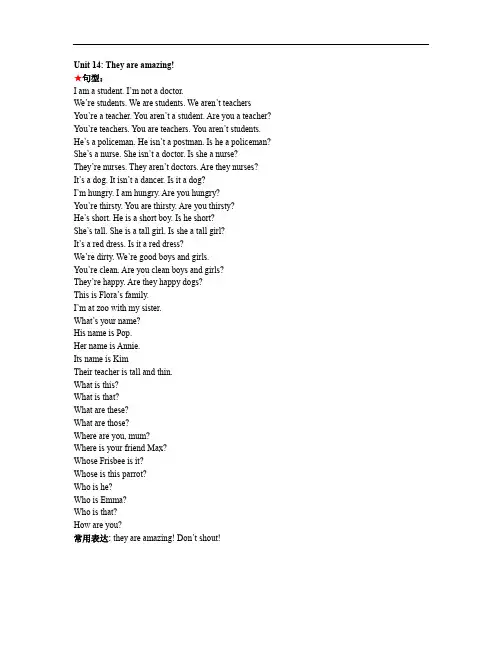
Unit 14: They are amazing!★句型:I am a student. I’m not a doctor.We’re students. We are students. We aren’t teachers You’re a teacher. You aren’t a student. Are you a teacher? You’re teachers. You are teachers. You aren’t students. He’s a policeman. He isn’t a postman. Is he a policeman? She’s a nurse. She isn’t a doctor. Is she a nurse? They’re nurses. They aren’t doctors. Are they nurses? It’s a dog. It isn’t a dancer. Is it a dog?I’m hungry. I am hungry. Are you hungry?You’re thirsty. You are thirsty. Are you thirsty?He’s short. He is a short boy. Is he short?She’s tall. She is a tall girl. Is she a tall girl?It’s a red dress. Is it a red dress?We’re dirty. We’re good boys and girls.You’re clean. Are you clean boys and girls?They’re happy. Are they happy dogs?This is Flora’s family.I’m at zoo with my sister.What’s your name?His name is Pop.Her name is Annie.Its name is KimTheir teacher is tall and thin.What is this?What is that?What are these?What are those?Where are you, mum?Where is your friend Max?Whose Frisbee is it?Whose is this parrot?Who is he?Who is Emma?Who is that?How are you?常用表达: they are amazing! Don’t shout!。
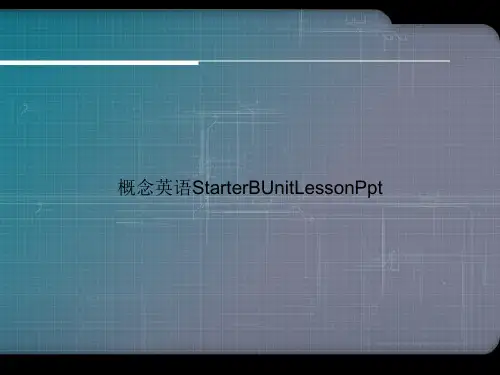

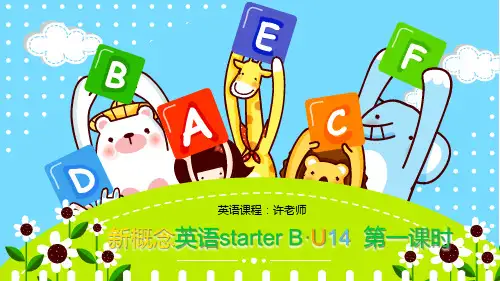
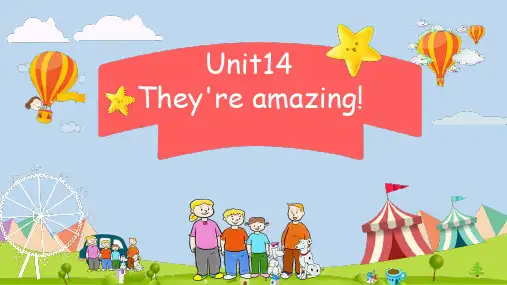
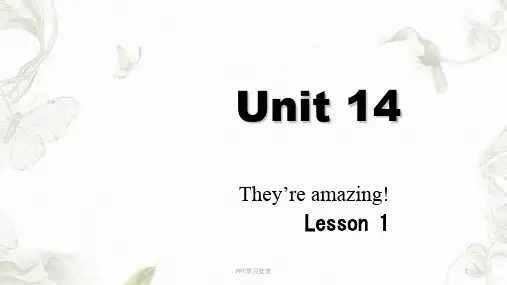
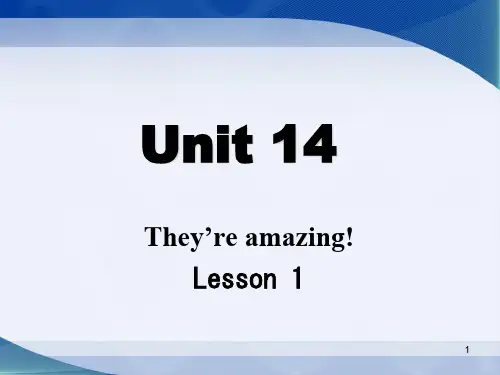

新概念starter B unit14
讲解单词和句型
【Words】
amazing adj.令人吃惊的,惊人的
stand v.站,站立
hungry adj. 饿的,饥饿的
shout v.叫,惊叫
wet adj.湿的,湿润的
fat adj.胖的,肥胖的
用卡片给学生展示单词,并让学生边写边记,每个单词抄写3遍。
【句型】
1.I’m, we’re/I’m not, we aren’t
2.You’re, you’re/ you aren’t you aren’t
3.he’s, he isn’t/ she’s she isn’t/ it’s it isn’t
4.they’re they aren’t
【grammar】
1.一般现在时一般疑问句和否定句的变法
一、先将句子分成三类:
1)含有am, is, are 的句子。
2)含有行为动词的句子,(如like,have,play,eat,
run,need)
3)含有情态动词的句子,如can。
(1)如果是第一类,即含有am, is, are 的句子。
只将
把am, is, are 调到句首。
I am 和We are 要变成are you,some变成any,my变成your,句末用问号。
否定句只在be后加not。
如am---am not; is ---isn’t; are----aren’t。
如:① I am a boy. (否定句)----- I am not a boy. (变成一般疑问句) -----Are you a boy? Yes,
I am. No, I’m not.
② She is my mother.( 变成一般疑问句) -----Is she your mother? Yes, she is. No, she isn’t. ③This is a book.( 变成一般疑问句) ------Is this
a book? Yes, it is. No, it isn’t.
④These are strawberries.( 变成一般疑问句) ----Are these strawberries? Yes, they are. No, they aren’t.
⑤ There is some chicken on the table.( 变成一
般疑问句) -----Is there any chicken on the table? Yes, there is. No, there isn’t.
(2)如果是第二类,即含有行为动词的句子(如like,have,play,eat,run,need等)时,要分两步看主
语。
①I / We / You / They 时,要借助于助动词do的帮
助来变成一般疑问句。
即句型为: Do + 主语 + 动
词原形 + 其他?否定句只在动词原形前加don’t。
例如:I have some tomatoes in my backpack.
(否定句)I don’t have any tomatoes in my backpack. ( 变成一般疑问句)-----Do you have any tomatoes
in your backpack? Yes, I do. No, I don’t. We play sports every day.
(否定句)---We don’t play sports every day. ( 变成一般疑问句)----Do you play sports every day? Yes, we do. No, we don’t.
②He / She / It 时,要借助于助动词does的帮助
来变成一般疑问句。
即句型为: Does + 主语 + 动词原形 + 其他?否
定句只在动词前加doesn’t,然后将单三还原成原形。
She watches TV every evening. (否定句)---She doesn’t watch TV every evening.
( 变成一般疑问句)----Does she watch TV every evening? Yes, she does. No, she doesn’t. 注意:如果是其他名词的话,在简略回答中要用人称代
词来替代,但替代都在第三人称中,即 he, she, it,
they四个中。
如: my mother ---she your brother ---- he a book ----it five photos-----they this/that-------it these/those------they my family name-----it Tom----he Mary--------she Amy’s sister -----she some friends------they
(3) 如果是第三类情态动词,如can 时,一般疑问句
只将can提到句首,否定句将can 变成can’t。
同时
注意一变二,二变一,三不变,some变any。
(情态动
词不受人称的限制)
I can play basketball. ( 变成一般疑问句)---- Can you play basketball? Yes, I can. No, I can’t. I can play basketball.(否定句)-----I can’
t play basketball.
2.名词变复数的规则
一般规则:+s 如:apple→apples,town→towns
以s, x, ch, sh结尾的名词: +es,如:bus→buses, box→boxes, bush→bushes, watch→watches
以o结尾的名词,有生命的加es,如:potato→potatoes, tomato→tomatoes, hero→heroes;无生
命的加s,如:radio→radios, photo→photos
以y结尾的名词,元音加y结尾直接加s,如boy→boys,
key→keys;以辅音加y结尾的名词,去y改i加es,如country→countries, library→libraries
以f, fe结尾的名词,去f变v加es,如:wolf→wolves, wife→wives(特例:roof→roofs)
【常用句型】
1.They can stand on their hands.他们可以倒立。
1. 讲解课文的内容,并让学生跟读,在课堂上读会,并布置回家巩固的作业。
2. 课文中的陈述句,举几个例子让学生参与变换一般疑问句的过程并学会回答。
最后让学生集体朗读课文。
3. 最后给学生总结本课所学的知识点:情态动词can 的用法,并让回家复习。